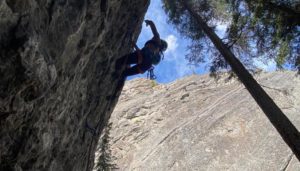Volume Versus Power: Learning How To MoonBoard
There are many ways to approach the MoonBoard. Is it better to train power or volume on this famous training tool?

The MoonBoard has many uses. While a person may us it for the Benchmarks, the question of how to use these Benchmarks remains.With so many approaches, which is best and under what conditions?
Volume
Volume training incorporates a high density of boulder problems and requires the athlete to recover and execute. The benefits of training in a volume format are multifold. First, a person learns how to flash consistently. Through high-volume exposure, the climber can make the conscious decision to climb a problem in a single attempt.
By knowing the holds, a climber can move with greater confidence and more easily believe in their ability to flash the problem. Furthermore, the standard length of the board provides a general sense of the endurance required for problems of most difficulties.
Where many climbers are familiar with endurance pump, new MoonBoard users will note the physically fatiguing style of the climbing. Although it is felt through the forearms, it is a more powerful pump than conventional endurance. In the same way that a person will notice their biceps and lats exhausted from power use, their forearms will feel powered out and hands will open after the first few grip intensive sessions.
This process repeats as climbers move into higher difficulties. As the board is standard and two-dimensional, climbers will find that the difficulty increases by virtue of grip strength, finger strength, and pulling power, thus asking for greater power from the developing climber.
Although technique is inherently necessary for climbing difficult boulder problems on the MoonBoard, there are very few boulders above V7 that simple technique can master.
As such, volume training is useful because it helps build muscle. In the same way that high reps at low weight allow us to build muscle, a large volume of lower MoonBoard problems provide opportunities to train the muscles we will need for all levels of difficulty.
A person does not need to train at capacity to improve, simply near capacity. The nice thing about the MoonBoard is that it’s a full body workout that puts near-capacity pressure on different climbing-related parts of our body at different points. As such, it strengthens the whole system and, through continued use, can make us very strong.
Power
Although the volume may seem like the way forward, perpetually working on boulder problems that you are able to complete also comes with consequences. Volume builds muscle, but it does not approach the multi-move difficulty of longer-term projects.
To that effect, volume is a bit of a muscle-based exercise. In a sense, each problem is within your capacity and regardless of fatigue, you can complete it. This conditions climbers to move with less precision and rely more on their increasingly strong mechanics. Although there are few problems above V7 on the MoonBoard that a person can climb with only strong technique, there are also few problems that a person can climb at their limit without technique.
The term technique is often misused to describe select aspects of climbing, when it is a broad topic that covers skills ranging from mentality through footwork, hips, timing, precision and pace. Boulder problems that fall beneath a person’s maximum capability require fewer technical skills than boulders of higher difficulty. As such, it is important to project.
Projecting is more than trying a single hard boulder problem. It is a comprehensive process that takes presence of mind, multiple days, and intentional movement. While things will become muscle memory overtime, a good project will at first feel difficult to flow through. Instead, it will likely feel like several challenging moves.
The lessons the MoonBoard teaches us through projecting differ among climbers, but some details are shared among many. The three greatest lessons are trying hard, maintaining tension, and finishing the problem.
Trying hard comes down to moving to the hold with intention, grasping it, and overcoming your urge to let go. The MoonBoard can feel uncomfortable and often requires mental discipline to make progress at your limit.
Tension maintenance is what makes all climbing easier, and, if done on the MoonBoard, makes you a very strong climber. With that said, the mini-pinch, hyper-aggressive style of climbing that is MoonBoarding does often allow a person to cut feet and still complete the move. Although this style is less transferrable to outdoor climbing, it too has uses. Still, a person can always choose a project that is difficult to complete if the feet cut. As there are many Benchmarks to choose from, the climber retains flexibility in this regard.
Finally, finishing the problem is a technique in itself. People newer to climbing, and veterans operating at theire limit will note that it can be easy to lose the climb after sticking a crux. Managing to retain your cool, slow down, and climb with control offers a high degree of benefit.
How Should you structure your sessions?
Consider what your weakness is. Some people recommend doing one projecting session every two volume sessions. Others argue it is best to work on one aspect of your climbing at a time. It might be recommended to spend three to four weeks, with a two-to-three session-per-week focus on volume, before taking a rest week and spending one or two weeks on projecting. Use the volume week to build strength and the projecting week to learn how to climb.
Featured Image by The Ultimate Climbing Gym.


